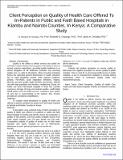| dc.description.abstract | bstract- Introduction
Quality is the ability to deliver services that satisfy the
consumer’s needs whereas service quality is the ability to meet or
exceed customer expectations, providing quality healthcare is an
ethical obligation of all healthcare providers and receiving
quality care is a right of all patients. Africa Countries including
Kenya has witnessed general deterioration in health indicators
due to rapid population growth, child nutrition problems,
poverty, HIV/AIDS, acute respiratory infections, malaria,
diarrhea, and poor quality health facilities and services. Nairobi
city with high population and Kiambu a neighboring County, the
Public and some Faith-based hospitals in these two counties
experience shortage of drugs and medical supplies, unaffordable
out-of-pocket costs for health services’ consumers, poor quality
of care due to overcrowding of the patients, thus services
provided are considered unsatisfactory.
Objective
To compare client perceptions on quality of health care
offered to patients admitted into public and Faith-based hospitals
in Nairobi and Kiambu Counties in Kenya.
Methods
A descriptive cross-sectional study of client perception on
quality of health care offered to in-patients in public and faith
based hospitals in Kiambu and Nairobi, Kenya was conducted. A
sample of 384 patients, 238 from public hospitals and146 from
Faith- based hospitals, and 276 were female and 146 male.
Comparative analysis of quality of health care in faith based
hospitals with public hospitals by use of SERVQUAL
dimensions to asses’ patient perception was carried out.
Results:
Faith-based hospitals overall mean was (4.23 on a scale of
1 to 5 & SD 0.347) showing positive opinions and public
hospitals mean was 2.62 (on a scale of 1 to 5 & SD 0.760)
indicating negative opinions among all five (Tangibility,
Responsiveness, Reliability, Assurance and Empathy)
dimensions. The overall T test was -24.688; there was a mean
difference in the patient’s opinions of public and faith-based
hospitals on perception of service quality. There was significance difference at p ≤ 0.05; T test and Chi-Square p value was .000 for
all five dimensions.
Conclusion
Patients had positive perception on service quality in
faith-based and negative perception on service quality in public
hospitals. There is need for re-structuring health service in public
hospitals, to put in empowerment strategies to provide patient
centeredness which is continuous quality health care
improvement process. | en_US |

